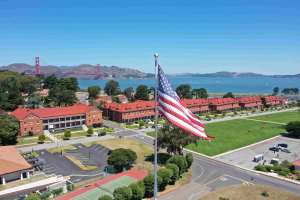Presidio's El Polin Spring Revitalized
Archaeological, natural treasures unearthed in major restoration effort

Presidio of San Francisco (October 26, 2011) — Its gurgling waters are said to hold mystical powers, and once quenched the thirst of the Presidio’s earliest residents. Now, El Polín Spring has been revitalized as a welcoming retreat and a focal point for outdoor education in the heart of the Tennessee Hollow Watershed. Three hundred feet of creek, buried in pipes for decades, have been “daylighted” and the water now flows above ground through a series of four wetland ponds; an asphalt road has been replaced with a new pedestrian trail and boardwalk, and the creek’s historic cobblestone channel, built in 1940 by the Works Project Administration, has been restored. The area is being replanted with native plants from the Presidio nursery, and is expected to be a green oasis by next spring.
“We brought back the wetlands that we suspect were originally here,” says Amy Deck, project manager for the Presidio Trust. “When the Army started building in the area following the earthquake in 1906, they channeled the water underground and filled in the wetland to make room for buildings, roads and other infrastructure.” The area is also rich in archaeological resources. A key feature is a terra-cotta tile basin that was unearthed during the daylighting work. It has been left uncovered, providing visitors a unique opportunity to view an artifact in its original surroundings.
“As archaeologists, often when we uncover something, we document it, photograph it and then we bury it again,” says Kari Jones, an archaeologist with the Trust. “It makes a big difference when someone can experience history like this up close rather than just looking at the picture.” Interpretive signs, the first in the park that will be in both Spanish and English, will provide visitors with information about El Polín’s history and natural resources. The tile basin is likely associated with another feature on the western edge of the site; the footprint of the first known colonial residence in San Francisco outside El Presidio and Mission Dolores.
The former adobe home is believed to have been occupied more than 200 years ago by the Briones and Miramontes families, including a young Juana Briones. Juana later became one of the area’s most prominent women of the time and a founding resident of the pueblo of Yerba Buena, the settlement that would become San Francisco. The house’s foundation, discovered in 2003 by Stanford University researchers, now lies beneath stone “walls” which were constructed from rocks encased in wire to commemorate the buried structure. The foundation was reburied to preserve the site for future research. Residents likely used a kiln, discovered just to the north of where the adobe residence was found, to fire the clay tiles used to construct the terra-cotta basin. The kiln remains buried for now. Plans are to re-excavate it in the future with the participation of community volunteers.
“We want to use this area as an outdoor classroom where we can interpret both cultural and natural history together and offer the public a glimpse into the daily lives of the Presidio’s earliest settlers,” said Michael Boland, Chief Planning, Projects Programs Officer. The only named spring in the Presidio, El Polín is one of the Presidio’s most cherished spots, a place where history and nature converge. The fresh waters that flow here once provided drinking water for Native Americans and the earliest Spanish-colonial settlers and are the source of one of the Bay Area’s oldest local legends. It is said that a young maiden who drank from the spring under a full moon would be blessed with many children (including a preponderance of twins) and eternal bliss. (The Trust says the water is not potable and advises against drinking it today.) El Polín is a project of the Presidio Trust and Golden Gate National Parks Conservancy. Funding was made possible by generous supporters including Mr. and Mrs. Matthew R. Barger, The James Irvine Foundation, The Kingfisher Foundation, Lynn and Peter Wendell, and the State Water Resources Control Board. To learn about how you can contribute, please contact Kathryn Morelli atkmorelli@parksconservancy.org or (415) 561-3050.
The Presidio Trust was established by the United States Congress in 1996 to administer the Presidio of San Francisco, an urban national park site located at the base of the Golden Gate Bridge. The areas overseen by the Trust include expansive open space and spectacular views, a 300-acre historic forest, and rare and endangered plants and wildlife. The park is home to 13 distinctive plant communities featuring 280 native plant species, 16 of which are rare or endangered. Thousands of hours of volunteer work have restored many acres of natural resource habitat. The Presidio Native Plant Nursery grows 60,000 plants each year to make this restoration possible. 21st-Century “green” practices are employed in all building and landscape rehabilitation efforts.
The Golden Gate National Parks Conservancy is the nonprofit membership organization created to preserve the Golden Gate National Parks, enhance the experiences of park visitors, and build a community dedicated to conserving the parks for the future. The Conservancy is an authorized “cooperating association” of the National Park Service, and is one of more than 70 such nonprofit organizations working with national parks around the country. To learn more, please visit www.parksconservancy.org or call (415) 561-3000.